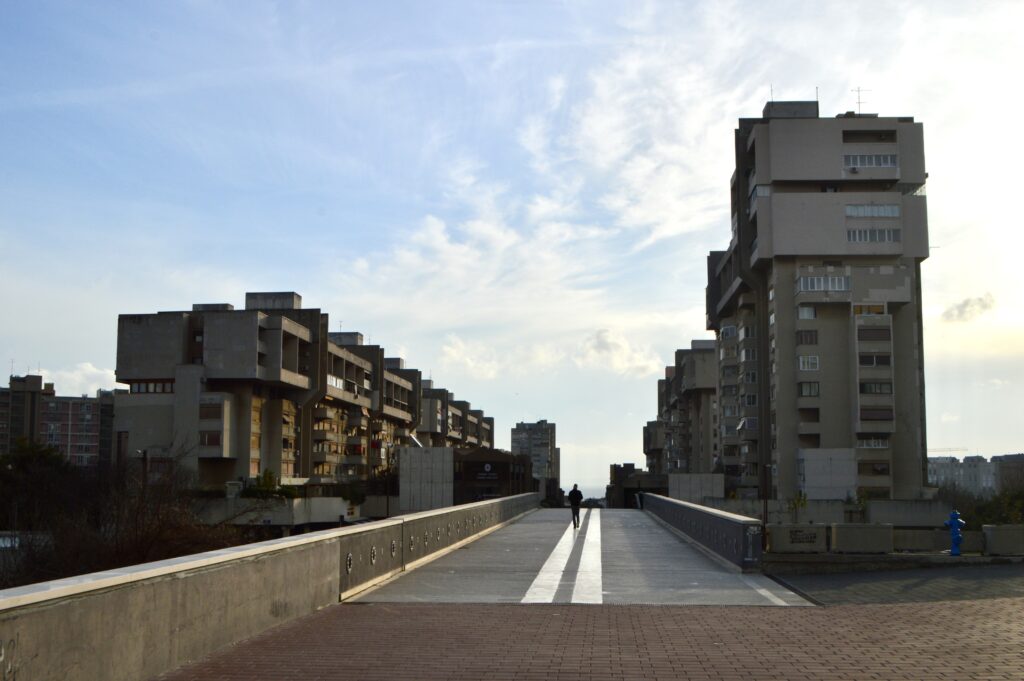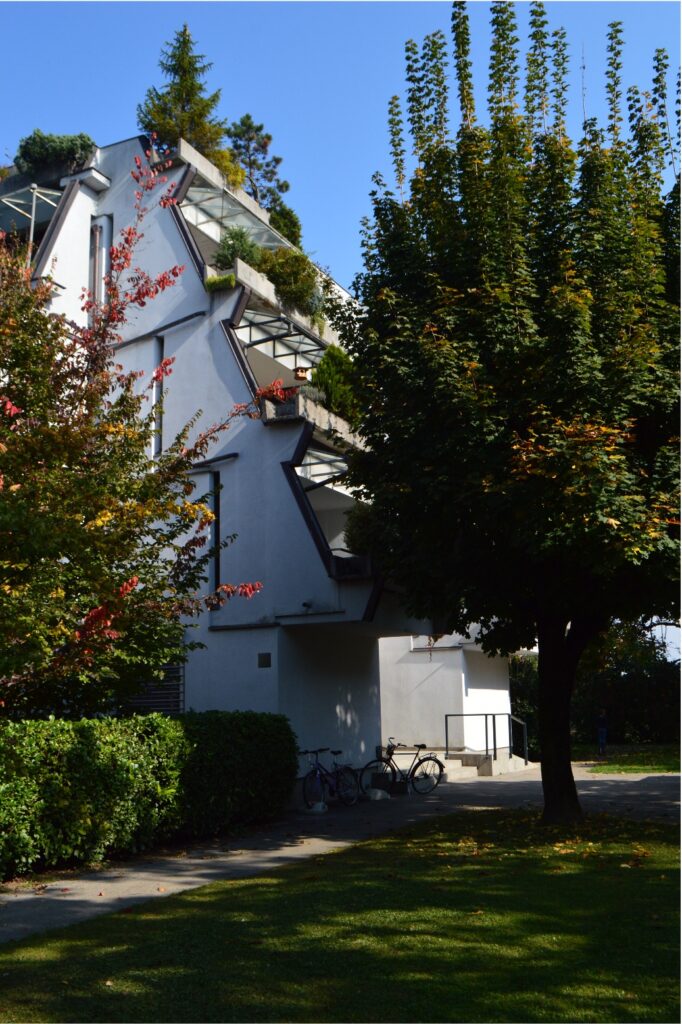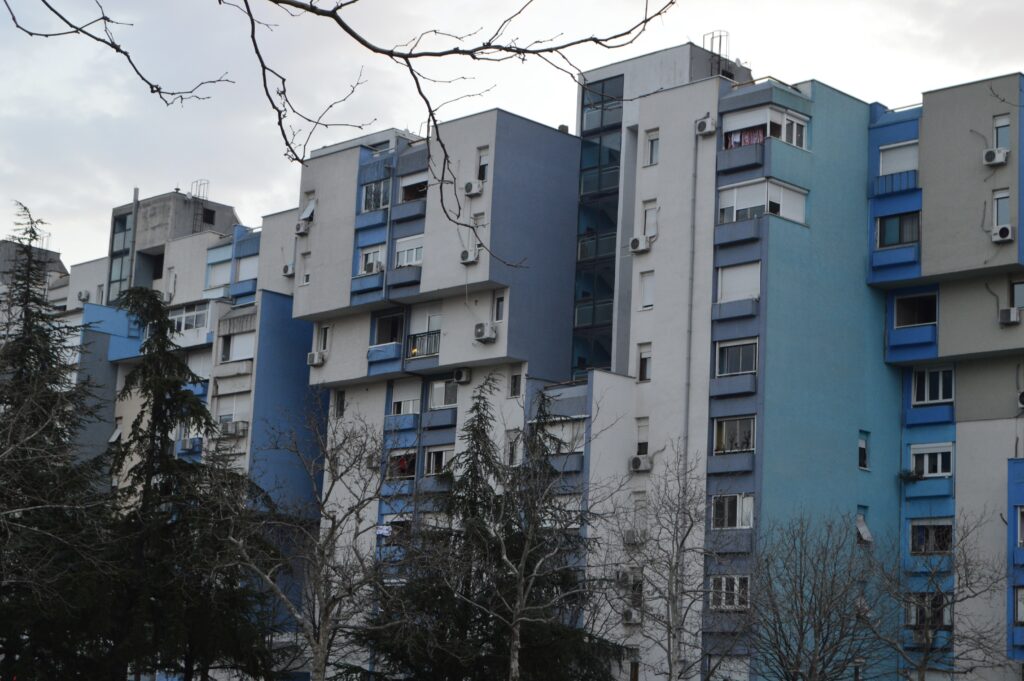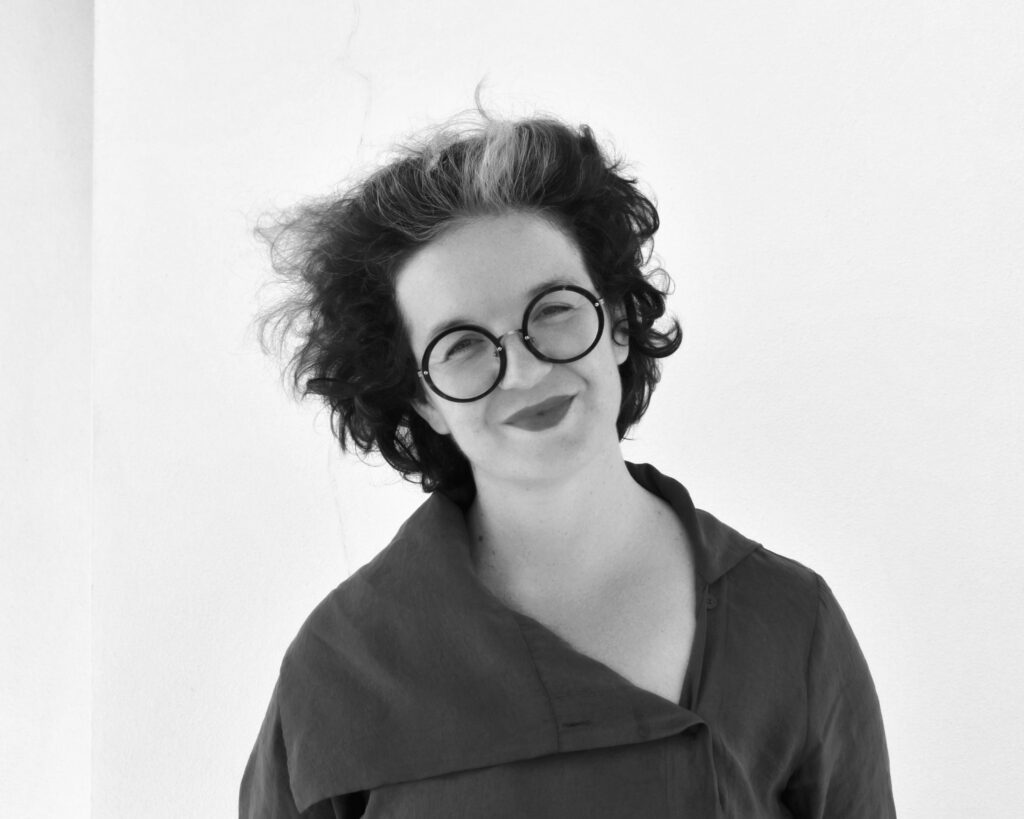
Note from LeftEast editors: Our member Sonja Dragović interviewed Dr. Lea Horvat about her work on the architectural and cultural history of socialist Yugoslavia, which has recently produced a book “Hard Currency Concrete: A Cultural History of Mass Housing Construction in Socialist Yugoslavia and its Successor States” (Gottingen: Vandenhoeck & Ruprecht Verlag, 2024; English translation forthcoming). Horvat’s research highlights the importance and the potential of mass housing stock produced under Yugoslav self-management, as well as the value of having and knowing this legacy at the time of the deepening housing crisis.
Sonja Dragović (SD): In “Hard Currency Concrete,” you navigate through the evolving landscape of mass housing in Yugoslavia and its successor states, from the optimism of the 1950s to the consequences of privatization and the aftermath of wars in the 1990s. How has the concept of mass housing transformed in the public and political imagination over these decades?
Lea Horvat (LH): In early socialism, it was primarily about envisioning the future to come. The debate was predominantly in the hands of architects, and I am discussing it based on the trope of a construction site. As socialist mass housing took off in the 1960s and the construction boom touched the lives of Yugoslavs, the main concern at this time was how to furnish such homes, largely unfamiliar to people used to rural housing or 19th-century apartments. Of course, not everyone did get an apartment at that time, but most people knew someone who did, and that is how socialist mass housing entered the sphere of everyday life.
Since the late 1960s and until the end of socialism, the discussions in the public sphere focused on the broader picture – the neighborhood or the dynamics within the housing estate. After the first results in the large-scale establishment of mass housing estates, various professionals, from architects to sociologists to environmentalists, started to question functionalist concepts of early mass housing, particularly the idea of zoning (residential, industrial…) and rigid geometrical arrangement of free-standing blocs within (green) spaces, with the minimized role of the street. However, this does not mean that the construction stopped; on the contrary, many projects in the 1970s and 1980s reconfigured what mass housing meant and worked as a kind of embodied criticism.
In the 1990s, mass housing apartments were privatized – offered for sale to their users without much discussion about it. However, there is much material from the realm of fiction where mass housing is negotiated; you see mass housing in movies and read about it in novels, so there was obviously a need to talk about these spaces at that time. That is why I am mostly preoccupied with the image of mass housing in my last chapter, but with the question of ownership consistently looming in the background. Even in the most anti-socialist political climate, no one seriously considered getting rid of this housing or offering some equally strong response to housing issues.
SD: In the book, you work with a concept of “medial arena” created within intra-Yugoslav commonalities and asymmetries. Could you elaborate on how these intra-Yugoslav dynamics influenced architectural practices and housing policies across different republics and how they contributed to the distinct cultural identity of mass housing in the region?
LH: My idea with medial arenas, which comes from Stuart Hall and the pop culture-friendly work of the Birmingham Center for Cultural Studies, was to limit my research to certain spheres of public debate where the issue figured prominently. I was tracing the issue of housing across genres and disciplines and trying to find the points where some kind of all-Yugoslav discussion happened. My approach privileges public discussions, but, of course, this is just one side of the (hi)story.
With time, I realized how my method also necessarily repeats some of the intra-Yugoslav economic power asymmetries along the Northwest-Southeast divide. Slovenia, Croatia, and Serbia, republics with a strong pre-socialist tradition of architectural press and institutions, also continued it after the Second World War, and the architects and construction companies from those republics were more often building in other republics than vice versa. This was also very palpable in the furniture industry, where Slovenia had a prominent role and enjoyed a high reputation throughout Yugoslavia. For example, Naš dom (“Our Home”), the first Yugoslav magazine dedicated exclusively to the architecture and design of the home, started in Maribor in 1967 and brimmed with product placements for Slovenian companies. At the same time, the public sphere is never a smooth place of rosy equality.

SD: Mass housing is often associated with uniformity, but your research shows the Yugoslav mass housing neighborhoods and apartments were anything but uniform. Could you comment on the interplay between public policies, innovative architectural solutions, and residents’ individual contributions to this outcome?
LH: In comparison to the German Democratic Republic, Soviet Union, or Czechoslovakia, where mass housing construction and research were rather centralized, Yugoslav mass housing was surprisingly diverse. This is the consequence of decentralization and self-management, the pillars of Yugoslav socialism.
Early on, experiments with mass housing construction were conducted in several places simultaneously. Sometimes such a structure was overwhelmingly complex in practice. For example, Grbavica I, built in the 1950s in Sarajevo, consisted of 31 buildings, involving 5 construction companies, 21 plans, and 14 investors. In Grbavica II, the structure was significantly simplified (with just one investor and one construction company), but the variety of plans was still present.
This constellation of housing construction did produce visual and spatial variety. The inability or refusal to produce thousands of apartments of the same type might have been interpreted as a shortcoming back then, but now it has turned into a strength because it has produced visual diversity in the cityscape.
However, diversity comes with some more ambivalent aspects. In a way, inequality also produces diversity. Since the mid-1960s, a variety of housing options within one neighborhood, from houses to high-rises, has become more and more acceptable. In 1964, Zagreb-based architect and critic Andrija Mutnjaković compared the span of living forms from 1- to 4-room apartments to the differences in transportation mode, from walking to driving Fićo1 to owning Mercedes. In his opinion, class differences were impossible to completely erase.
A similarly ambivalent issue is the use of generous public space, an integral and essential part of mass housing estates. Henri Lefebvre’s “right to the city” encouraged citizens to use and shape public spaces. At the same time, the idea that public space is less a space envisioned by architects and urban planning experts and more of an unfinished space opened the door for commercialization that flourished in postsocialist circumstances.
I do think that in many cases Yugoslav mass housing did manage to achieve variety while sharing a broad common frame of reference. Ultimately, I believe that socialist mass housing does work as a common ground, an ultimate socialist urban experience. The variety throughout post-Yugoslav space is present, but these buildings and their inhabitants do share the problem of atomized ownership and the need for sustainable solutions for renovation and a safe, sustainable future.
SD: Your study extends into media reinterpretations of mass housing in the 2000s. What insights do these narratives offer about the collective memory and contemporary significance of mass housing in post-Yugoslav societies?
LH: A range of nuanced, playful narratives aware of stereotypes regarding mass housing appeared in the 2000s and later on. For example, The Brightest Neighborhood in the Country (Marko Škobalj, Ivan Ramljak, 2001), a short mockumentary portraying one mass housing estate in New Zagreb as the site of intellectual excellence, subtly shows some of the advantages of mass housing estates. Another of my favorites is Kurrizi by Orgesa Arifi, a documentary gathering memories of the 1990s in Kurrizi, the epicenter of Prishitina’s youth culture and nightlife.
In the late 2000s, a surge of interest in local history reached mass housing estates. People connected in Facebook groups and online, where they’d exchange old photos and memories. Some of these activities turned into exhibitions, for example, “50 Years of Trnsko” exhibited at the Zagreb City Museum.
There was also a notable interest in a variety of urban renewal interventions, especially in mass housing neighborhoods. The impulse came from a younger generation of designers, architects, artists, and activists. For example, the NGO ProstoRož worked in Savsko Naselje, Ljubljana, KANA/ko ako ne arhitekt2 in Podgorica, City Acupuncture in several post-Yugoslav cities, and Obojena klapa in Sarajevo brought large-scale street art to the Ciglane neighborhood. Although the initiatives have different undertones and levels of activism, they do share the centering of the enhancement of public space, local identity, and community in mass housing neighborhoods. At the same time, these initiatives are often project-based, and precarious – they rely on the enthusiasm of their members and cannot replace structural changes that would stop the pressing commodification of housing and living spaces.

SD: Researching Yugoslavia’s architectural history poses a pragmatic problem, with archives scattered across the region and organized differently in different states. How did you approach this challenge?
LH: I do believe that “methodological nationalism” is, in many cases, a question of resources, and one must be able to afford to engage with the transnational and global trends in current academia. My robust PhD funding from the German Academic Scholarship Foundation, along with generous field trip support, alleviated many financial worries I had. However, I very much appreciate the abundance of excellent microhistories on specific mass housing estates throughout former Yugoslavia.
I think what really matters here is to be mindful of the limits of your approach, what it can tell you, and what it cannot. For example, when I tried to proceed in Podgorica or Sarajevo in a similar way as I did in Ljubljana or Zagreb, it just did not work out. This could lead to a conclusion that there is “nothing,” which would obviously be ignorant since you can clearly see a significant presence of mass housing in the city. For me, this meant that I had to look beyond my initial plan and consider other places where I could find important stories. In the case of Sarajevo, I realized that the history of the siege had to be present. That’s why I worked with the extensive collection of photography from that time kept in the Historical Museum of Bosnia and Herzegovina.
Finally, I do believe we have to be very open about our limits and what we don’t know. I included all capitals of former Yugoslav republics with the exception of Skopje. I planned a field trip, but then COVID hit. I’d love to include the capitals of autonomous provinces as well, but I do not think it is responsible to write about the Prishtina case without speaking Albanian. So in the case of Skopje and Prishtina, I briefly mentioned them and relied on secondary literature. I do think there is much more to learn about these contexts from someone else, and I am excited about the work of future researchers.
SD: Parts of your doctoral research have been published before this comprehensive book, like the article “Housing Yugoslav Self-Management: Blok 5 in Titograd.” What initially drew your interest toward studying Blok 5, now in Podgorica? Why do you think it is an important example of self-management in Yugoslav mass housing?
LH: Podgorica was another case of adjusting my methodology after hitting a wall. I got in touch with KANA/ko ako ne arhitekt, as I had read their study on the public participation of Blok 5 in Podgorica, and I talked to the architect Mileta Bojović. Blok 5 checks all the boxes of an exceptional mass housing project, but it was basically unknown beyond Montenegro. Bojović started his PhD in France under Lefebvre but went back to Montenegro to engage in the construction of Blok 5. This case shows how an off-center position could offer more than one could expect; in this case, the project went relatively smoothly. In my opinion, the centerpiece of self-management in this case is the reduction of bearing walls to a bare minimum to accommodate a variety of layouts. As originally envisioned, the future dwellers should have had the possibility to discuss their preferred layout with an architect. The connection between the architect and the dweller was not logistically and administratively supported in the end, but some dwellers did find a way to get advice. The construction is quite daring, with many protruding elements on the façade, and in a way, it evokes the dramatic mountainous landscape of Montenegro, as the architect himself states. I think that the example shows a compelling understanding of self-management, not as a way for the architect to “wither away,” but as an offer of a framework for respectful exchange.

SD: In your conclusion to the Blok 5 paper, you mention the potential of Yugoslav self-management’s legacy to offer “meaningful incitements to self-organization.” Could you expand on what this might look like in practice, particularly in the context of urban planning and community engagement today?
LH: I see learning about the past as something that gives you a new energy and a sense of defiance in facing present struggles. It shows you that some things you might consider impossible have been accomplished before, sometimes in economically and technically far more challenging circumstances than today. I believe the example of KANA/ko ako ne arhitekt and their activism against the destruction of public space and the public good beyond Podgorica shows the way to go. Where I see my modest contribution is in making it clear to people that this architecture is significant. Young designers, architects, and similar practitioners could provide people with the tools for meaningful engagement. Of course, there is a limit to what you can achieve without changing the political system, and it might only be a temporary fix, but having a patch is often better than nothing, and does not conflict with pushing for a better mass housing and healthcare system.
SD: Your work expands beyond research in cultural and architectural history. You’ve been a member and author of the Croatian feminist portal Muf; a couple of years ago, you published a book of essays titled “Impractical Advice for Home and Garden: Feminist Readings of Women’s Everyday Life,” and you’re now co-editing the platform “Women* Write the Balkans.” How does this work relate to your broader research interests and to your theoretical approach? What will you work on next?
LH: My writing for Muf and its successor Krilo was complementary to pursuing my PhD; it enabled me to explore my love-hate relationship with domesticity in popular culture and my personal life. I often feel that academic formats and writing are restraining, and I am trying to express my playful and silly side as well. I am increasingly trying to combine these two modes; Women* Write the Balkans, which I founded with Ana Sekulić, is an attempt to explore the connection between experience and expertise in imaginative pieces of writing. My current research project focuses on coffee, gender, and labor in the South Slavic part of the Habsburg Empire. After focusing on the concept of home for a solid number of years, I was yearning to learn more about women in the public sphere. I am also very excited to delve into the struggles of presocialist workers.
The interview was conducted in anticipation of the workshop Housing+, organized by Space SyntaKs from Priština and KANA/ko ako ne arhitekt from Podgorica. The workshop involves architects, researchers, activists, and cultural workers and intends to explore the social, cultural, economic, urban, and architectural evolution of collective (mass) housing during its construction in the second half of the 20th century.

Lea Horvat is a postdoctoral lecturer at the Friedrich Schiller University Jena, Department of Cultural History. Her habilitation project focuses on coffee, gender, and labor in the southern semiperiphery of the Habsburg Empire. Her monograph Harte Währung Beton, a cultural history of socialist mass housing in Yugoslavia, was published in 2024 by Böhlau. She holds a PhD in History from the University of Hamburg and an MA in Art History and Comparative Literature from the University of Zagreb. She is an editor and co-founder of the platform Women* Write the Balkans.
Sonja Dragović is a PhD researcher at the Center for Socioeconomic and Territorial Studies – DINÂMIA’CET-Iscte at the University Institute of Lisbon, where she is pursuing doctoral studies at the Department of Architecture and Urbanism as a scholarship holder of the Portuguese Foundation for Science, Research and Technology. Her interests include analyzing practices of urban activism and working with local communities toward improving participatory methods, public policies, and shared spaces. She is one of the editors of LeftEast and a member of activist and research collectives KANA/ko ako ne arhitekt and Biciklo.me (Podgorica) and Laboratório de Estudos Urbanos (Lisbon). She’s also a member of the Green Kolašin initiative.

Footnotes
- Zastava 750, a small, working-class car produced in Yugoslavia, widely known by its nickname “Fićo” or “Fića.”
- KANA/ko ako ne arhitekt is an activist organization of architects and researchers from Podgorica, formed in late 2015 to promote the social engagement of architects, criticize the neoliberal approach to urban development, and advocate for preserving the 20th-century architectural heritage. The name “KANA” is an homage to Svetlana Kana Radević, a prominent Montenegrin and Yugoslav architect, and the acronym for the rhetorical question of “Ko ako ne arhitekt?”, meaning “Who, if Not an Architect?”. It aims to draw attention to the importance of having architects stand up against destructive urban development policies.
